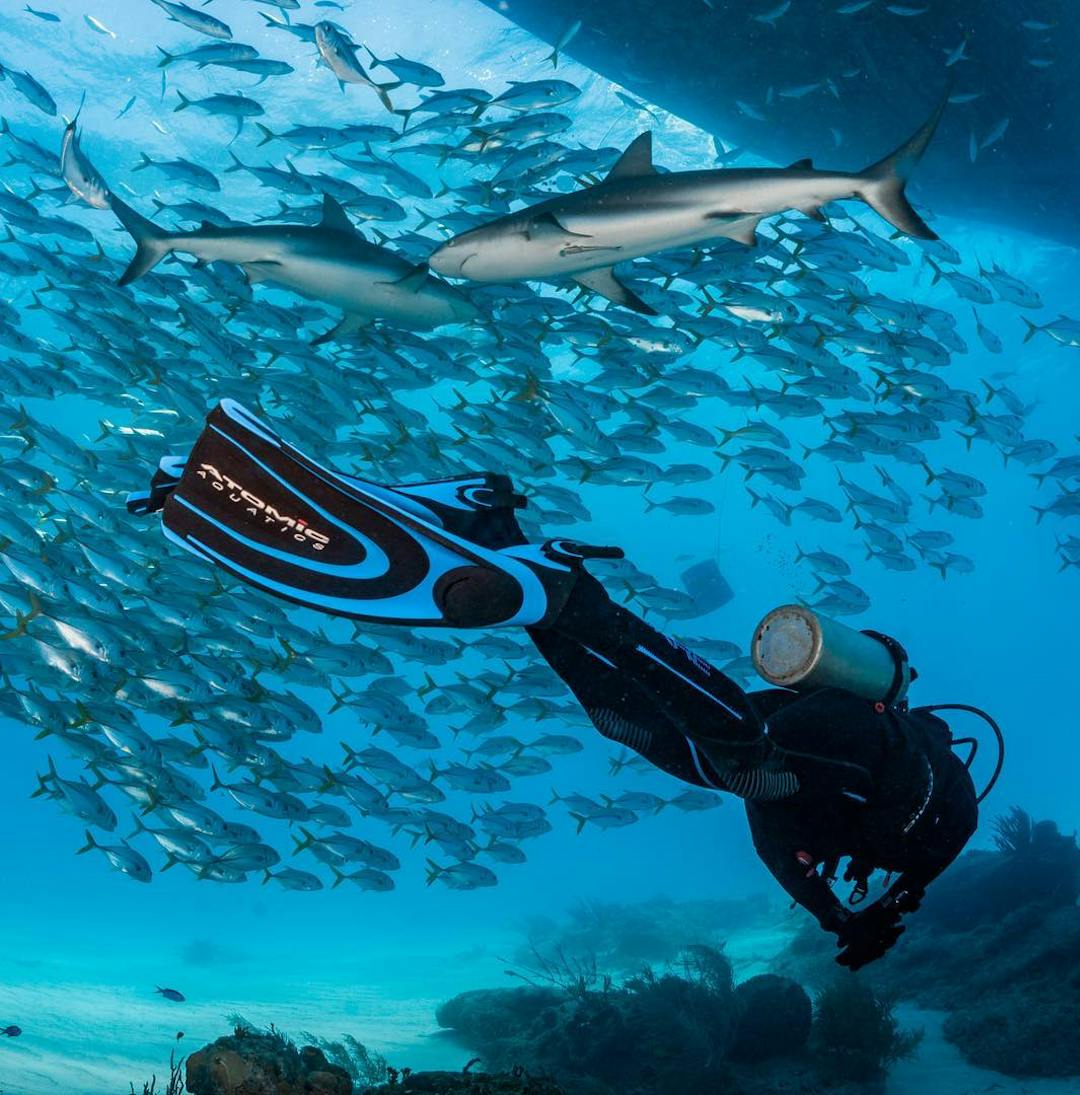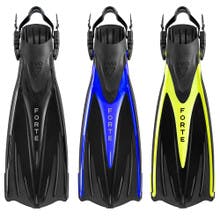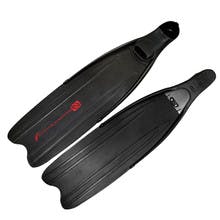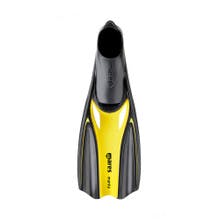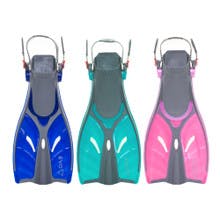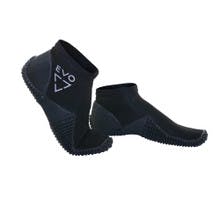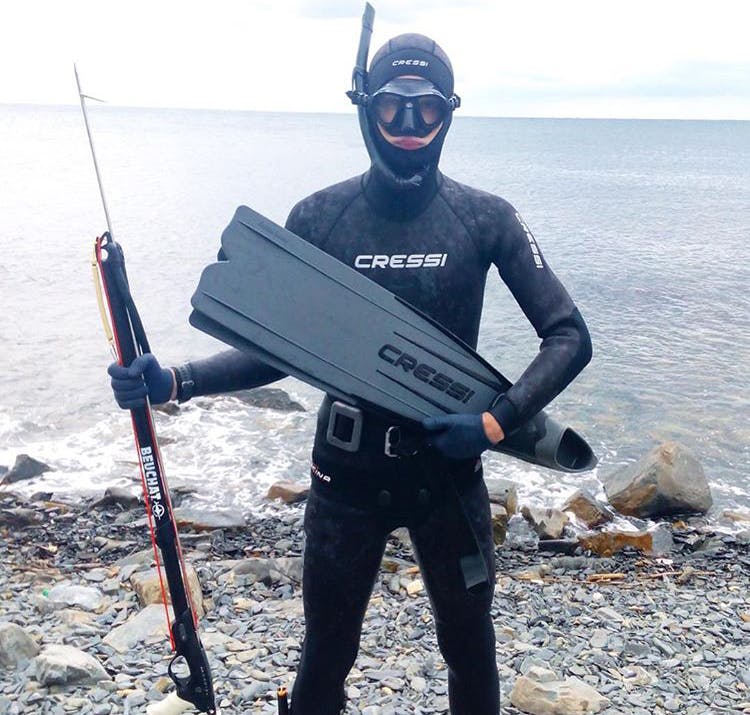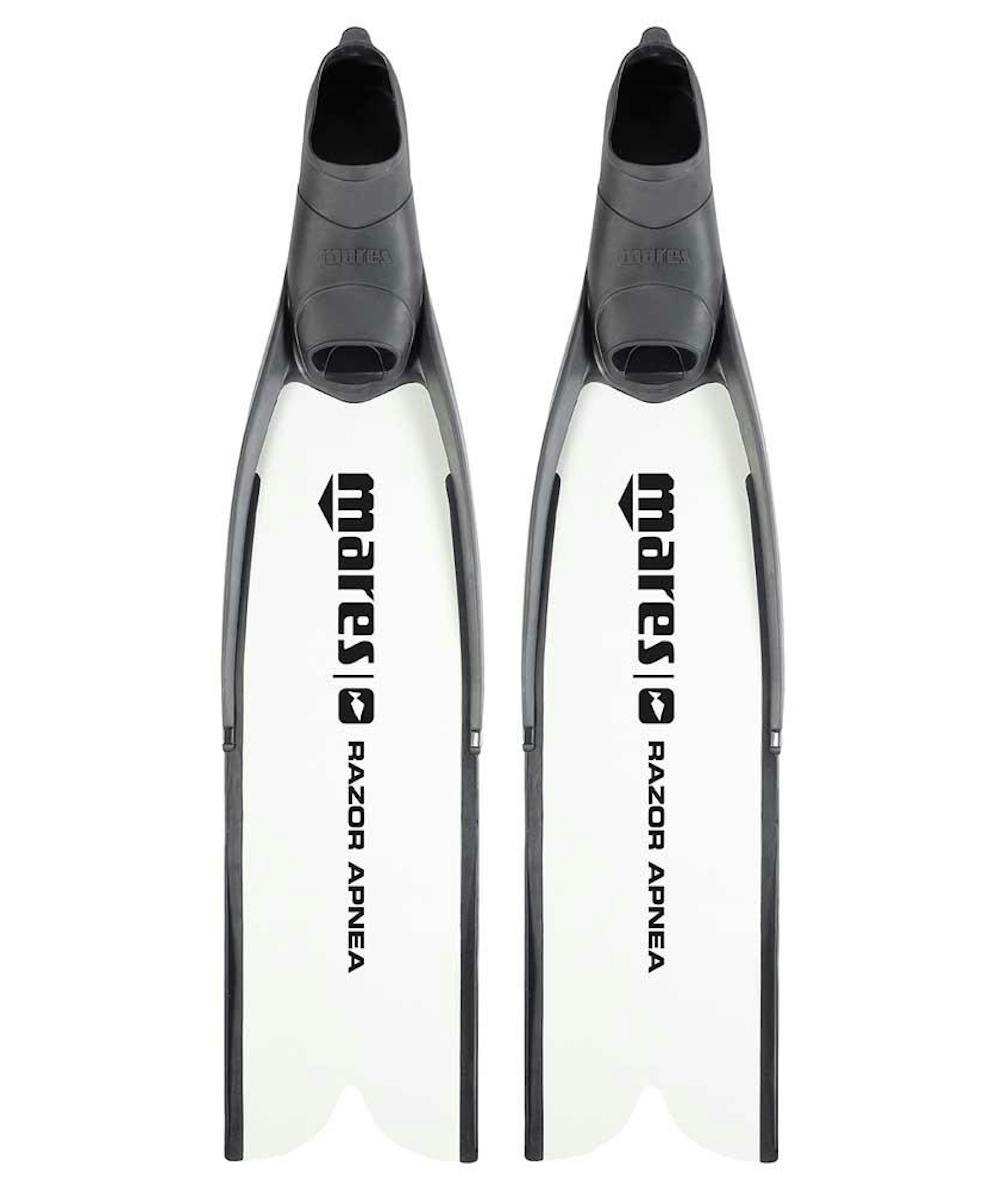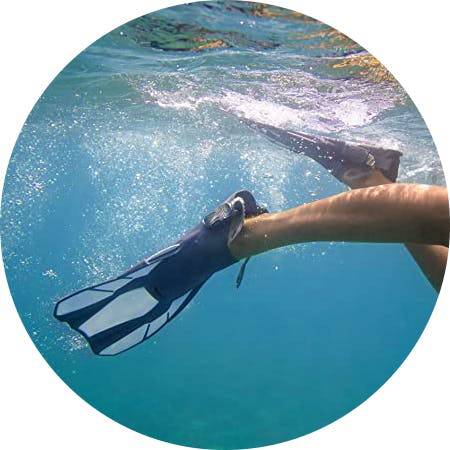Scuba Fins Buyer’s Guide

If you’re a new diver, you may be overwhelmed by the diversity of options for scuba fins out there on the market. No worries, we’re here to help sort things out. But first, before we dig into the “this type” and “that type” and the “whys” of everything in the world of dive fins, let’s take it back to a basic understanding of what fins do exactly.
So, what do scuba fins do? Well, on the simplest level (without getting into the deep physics of it all), they propel you through the water, giving more power to your kick. Technically, you could dive, snorkel, and freedive all you want without fins, but you’d perhaps find yourself spending loads of unnecessary energy on kicking while not getting quite as far as you’d like.
As a diver, you know that the more energy you exude, the more breaths you take, and the more breaths you take, the quicker you go through the air in your tank—which essentially diminishes your bottom time substantially. So, in order to save your energy, save some tank time, and extend your bottom time, scuba fins are a must. They help to make us a little more fish-like in form, thrusting us through the water with significantly less effort on our part. Fins are also rather helpful if you find yourself in stronger currents on your dive (as opposed to being caught in those same currents without fins—trust us, the struggle is real). But each fin type has its strengths and weaknesses depending on the activity you’re diving into, so let’s take a look at each type and see what fins you’ll need for your adventure.
Scuba Diving Fins
With more variety in scuba fin styles when it comes to rocking the tank-and-reg setup, let’s start there—the scuba fins. You have split fins, blade fins, pivot fins, open heel, full foot, and more styles coming as time flips on. Some scuba fins are better suited for warm water dives while others are better for cold water. And some fins are designed for speed while others are made for conserving your energy.
So, ideally, you’ll want a scuba fin that can do it all right? Make you feel as fast as a Mako while hardly kicking at all. Possibly a set of scuba fins that you can take with you on warm and cold water dives. It’s possible to find such a fin, but first, let's get to know all the fins. Knowing your options will help you select the right fins for your style and your dive profile.
To do this, we are going to first explore the original fins that divers have used for decades—the blade fins. Blade fins have one single, undivided blade that provides maximum thrust through the water. With these Atomic Blade Fins, there’s so much space across the blade. This is so the water works with you to push you forward, providing ample power for your dive. This is great if you find yourself in stronger currents while diving. However, because there’s so much resistance against the blade fin, these fins can be difficult for the less experienced. Therefore, while they’re amazingly powerful, they tend to draw more energy on your part to get going.
Another popular style of scuba fin is the Split Fin. The split fin is designed with a split right down the middle of the fin. Some splits are longer while others are shorter, but the idea is the same. The split down the middle of the fin web creates less water resistance while still providing sufficient propulsion. This means that you’ll still get some great speed through the water while requiring less effort on your part. Many new divers, and those with frequent knee pain, tend to prefer the splitfin. The Atomic Aquatics Splitfins are a great example of the splitfin design. They're designed for maximum speed and efficiency, while providing adequate thrust through strong currents. This is due to the power rails along the sides for stability.
The pivot blade is a newer design. As we explore its benefits, we will also begin our discussion on open-heel versus full foot scuba fins. Since these ScubaPro Seawing Nova Fins are open-heel, we will begin there. At first glance, these fins may seem just like the blade fin that we discussed earlier. However, notice the hinge where the foot pocket meets the blade. This creates a “pivot” on the scuba fin when you kick which creates a more hydrodynamic flow. The pivot blade fins offer the thrust and power of a conventional blade with the speed of a split fin. Enjoy exploring new innovative designs and want a versatile scuba fin? Then the pivot blade scuba fin may be the right fin for you.
In addition to the Seawing Nova’s interesting design, you’ll also notice that they are open-heel fins. Open-heel fins tend to be more versatile when it comes to dive conditions. That's because open-heel fins are worn with a dive boot. Since dive boots vary in thickness, this style is easily worn in warmer and colder water climates. Also, open-heel fins are adjustable, so you’ll be able to get a more comfortable, personalized fit once adjusted. And since you’ll be wearing dive boots, you'll find that it’s easier to walk to your dive destination. Once there, simply don your scuba fins when it’s time to jump in.
While open-heel fins seem like a great option for quite a few reasons, there are plenty of benefits with full foot scuba fins as well. For one thing, there is no need for dive boots. The foot pocket is smaller and more anatomically designed, fitting all the way around the heel like a shoe. Because of the smaller sizing and closer fit, you’ll notice when shopping for full foot fins that the sizes are more specific than with open-heel scuba fins. Additionally, many traveling divers enjoy that they don’t have to pack extra gear by bringing dive boots. But since you can’t wear thick dive boots with full foot fins, they’re not exactly ideal for cold water diving. So, if you like traveling to warm dive spots (and like to travel light), you may prefer full foot fins like the Mares Avanti Quattro Power Fins.
Now that you know about scuba dive fin features, you’ll be able to pick and choose what features you like best. Maybe you’ve already decided which features you’re drawn to that match your scuba style. A few of these features carry over into sport-specific fins like freediving and snorkeling. When looking for fins for these activities, some of the features listed above may help you decide for those as well.
The Elegant Freediving Fins
Just like with scuba fins, know that what fins may work for some may not work for others. There is no, “This is the best freediving fin out there, period,” situation. While you may find you prefer plastic fins, your best friend and dive buddy may prefer carbon fiber. You and your friend likely have different goals and aspirations in diving as well as different strengths, thus different preferences. So, don’t go into this section looking for the one great fin of all fins and that’s it; really start to consider your personal interests as a freediver, as well as your experience level and lower body strength. Each of these things will make all the difference in finding the freediving fins that are just right for you.
First things first, let’s talk about materials. When you start the hunt for your ideal freedive fins, you’ll come across plastic, fiberglass, and carbon fiber blades. Each of these materials is listed in order of snap responsiveness (your kick’s “echo” creating a second burst of power for maximum efficiency), weight, fragility, and price. Each material is ideal for certain activities and conditions, and each material is ideal for a certain level of diver. Additionally, you’ll often be able to choose the stiffness you want out of your fins. Keep in mind your leg strength and desired speed when choosing.
Let’s take a look at plastic fins first. Plastic is certainly the sturdiest and most durable material for freediving fins. It’s perfect for beginners or those diving in shallower waters over reefs and rocks. These fins are more equipped to take a hit or two. The downside to using plastic material for freediving fins is that they can feel a bit heavy in the water. Smaller divers may find plastic fins difficult to kick, causing them to spend more energy while not getting far. But don’t think all plastic fins are heavy or lacking in efficiency. For example, the Cressi Gara 3000 LD Fins are made with plastic and are lightweight with a moderately reactive snap. If you’re a brand new freediver, this is an ideal material while you’re still getting your feet wet with the sport.
Fiberglass is our next material of study, and this material is ideal for those who are adventuring into deeper realms of their freediving experience. Fiberglass material is quite fragile and often better suited for open water. But what they lack in rugged durability, they definitely make up for in efficiency. Fiberglass tends to have a much more reactive snap when kicking and is far more lightweight than plastic. This effect will cause greater propulsion through the water with less effort on your part. The Mares Razor Apnea Fins are a great example of fiberglass fins that attempt to effectively balance snapability and durability.
Our final material to explore for freediving fins is the often most coveted carbon fiber fins. These fins feel light as a feather, and it may seem like all the pros use carbon fiber and, well… that’s because they do. They’re the most expensive, most fragile, and most reactive. Because of their fragility, they’re not great for cruising shallow reefs, but if you’re looking to go deeper in the sea, even as a freediving competitor, then the investment may be worth it.
Stiffness is something that can be determined regardless of material, though most freedivers tend to lean towards soft and ultra-soft blades. Usually the only reason a freediver would get a medium stiffness blade is because they’re diving in stronger currents. But again, musculature is a consideration and while small divers may prefer ultra-soft fins, those who are quite strong in their lower bodies may prefer medium stiffness to match their powerful kick. Otherwise the softer blades may not be strong enough in relation to the power behind their kick and they’ll find themselves kicking more than need be.
Another consideration with freediving fins is whether or not you want an integrated blade with foot pocket or a separate blade and foot pocket. With a separate blade and foot pocket, you’d be able to change out your fin blades. However, with the integrated blade, the blade and foot pocket are permanently attached.
What’s the purpose of this? Well, if you have a separate blade and pocket, you could potentially have the same foot pocket (which you know fits already) and buy different blades for it. This is ideal if your blade breaks and you need to replace it with a new one. The downside is that you have some hardware to deal with which adds weight to the fin. On the other hand, they’re great to travel with since you’ll be able to lay your fins flat more easily. The integrated blades and pockets make things a bit simpler since you don’t have to worry about parts, pieces, and assembly. In addition, they tend to be more lightweight; however, if one of your blades breaks, you’re looking at a whole new pair of fins.
So when it comes to freediving fins, it’s essential to be aware of your personal experience, musculature, your freediving activity, and certain preferences like integrated, separate, carbon fiber, or plastic. And also note that it’s highly important that your freediving fins fit properly. If they’re too loose or too tight, your dive (and your feet) could suffer the consequences. Scroll on down to “If the Fin Fits…” to find more information on fitting, or to be absolutely sure you have the perfect fit on your first try, you can come visit us at your local Divers Direct and one of our experts will be able to assist you in finding just the right size.
The Snorkel Shorties
You may find that buying snorkel fins is a little easier to navigate than buying scuba or freediving fins. While they are quite similar to the scuba fin styles, there are a few differences to be aware of. Snorkeling fins tend to be much shorter and smaller than scuba fins. This is because these fins propel you leisurely along the water’s surface while scuba fins assist in taking you and all your heavy gear deeper into the water, meaning you will need a much more powerful blade for your scuba fins. While you can use scuba fins for your snorkeling fun, you could find that they’re too heavy and weigh you down along the surface, but the shorter snorkeling fins, like the Ocean Reef Duo Fins, are perfectly ideal for any surface cruise while you explore the sights of the sea.
So while you know you’re shopping for something a little smaller than your everyday scuba fin, you’ll still need to figure out whether or not you want open heel or full foot pockets. The exact same considerations apply from the scuba fins section, where the open heel fins can be adjusted to your specific fit but will need neoprene booties to prevent chafing, and the full foot pockets won’t need any extra gear but are only recommended for warm water adventures. Since most snorkelers only cruise through warmer tropical waters, many prefer the full foot pocket fins like the Mares Manta Snorkeling Fins.
That’s about it when it comes to snorkeling fins. Remember, less is more here and your main decision will fall into whatever foot pocket preference is. But no matter what kind of fins you have—snorkeling, freediving, or scuba diving—you’ll always need to have the right fitting foot pocket, otherwise you’ll find yourself having an uncomfortable experience and potentially waste tons of energy. Let’s explore fin fitting in the next section, shall we?
If the Fin Fits
It shouldn’t be surprising that you’ll want a fin that fits comfortably. Whatever activity you’re buying a fin for, you’ll be participating in an athletic sport where your legs will be taking on a lot of the work. Just like when you're buying running shoes, you’ll want to make sure they’re the most comfortable fit. This is so that your feet, legs, and joints won’t be aching later due to an improper size. Open heel fins can be quite popular because you can adjust the strap to find the perfect fit for you. When it comes to freediving fins, you’ll find that full foot pockets are ideal to reduce drag and make the fin feel more like an actual extension of your foot for optimum efficiency.
All fins should have a size guide when checking them out online. The only way to be 100% sure your fins are the best fit for you, is to try them on. When trying on full foot fins, you’re looking for a “Goldie Locks” fit. You don’t want them to be too big because you’ll find that your efficiency drastically drops and you’re wasting tons of energy. But be sure that they’re not too tight as well. This could cause them to pinch your feet, prevent proper circulation, and cause quite an uncomfortable time in the water.
Many divers wear neoprene socks with their full foot fins to prevent chafing and blisters. If you plan to wear neoprene socks with your fins, make sure to allow space in the foot pocket for the socks. When trying on open heel fins, the same concept applies. Make sure you allow extra foot pocket space for the added thickness of a neoprene bootie. It can be beneficial to try the fin on with the bootie if you have it with you.
In Finclusion
Yeah, okay, that was a really bad pun, but can you blame us for trying? Anyways, we hope you’re now on the right track to finding the perfect set of scuba fins, freediving fins, and snorkeling fins for you. There are common considerations between them all and specific things to notice in certain fin styles. With everything you’ve learned here, you can browse online or waltz into that dive shop like a pro with what you know. So happy shopping and happy finning!
Scuba Fins FAQs
Can I use my Scuba Fins for Freediving or Snorkeling?
Although Scuba Fins can be used for both Freediving and Snorkeling, the different fins feature different construction to aid specifically in the type of activity you’re engaged in. However, some fins are made to cross over from one activity to another. So when you’re looking to buy fins, consider the activities as well as environments you’ll be in and decide based on those criteria.
How do I store my Scuba Fins?
To properly store your fins, clean them with fresh water, then make certain they are dry. Still have the plastic insert that came with the fins? Place them in the footbed to aid in holding their shape. If you have open heel fins, you can either lay them flat, stacking one on top of the other with the heels at opposite ends, or place them upright with the heel against the ground and the fin blade resting against the wall. If you have full foot fins, lay them flat so as not to damage or bend the footbed.
How should Scuba Fins fit?
Above all else, your fins should be comfortable and the heel should not slip off. When sizing, put them on and lift your heels off the ground while putting pressure on your toes. If your heels slip, they’re too large. If you’ll be wearing Dive Socks or Dive Booties with your fins, be sure to wear them when sizing to ensure a good fit.
What size Scuba Fins do I need?
Typically, dive fins run about 2 sizes smaller than shoes. Use your shoe size for reference or as a starting point. But the size should be selected based on actual fit and feel opposed to any particular number. Additionally, most manufacturers have size charts available to help ensure a correct fit.
Why do I need fins when diving?
Fins allow you to propel yourself through the water with less effort, which means less air consumption, longer dives, and more fun!
What kind of dive fins are there?
Fins are designed for specific activities, such as Scuba diving, Freediving, and Snorkeling. Within those styles there are variations including Full Foot or Open Heel/Adjustable, as well as fin blade variations including Paddle, Hinge, and Splitfin.
What are the best Scuba Fins?
There really is no single fin that is best for everyone. Fins should be selected taking into account many factors including intended activities, price, weight, dive conditions, and maybe even available colors.


